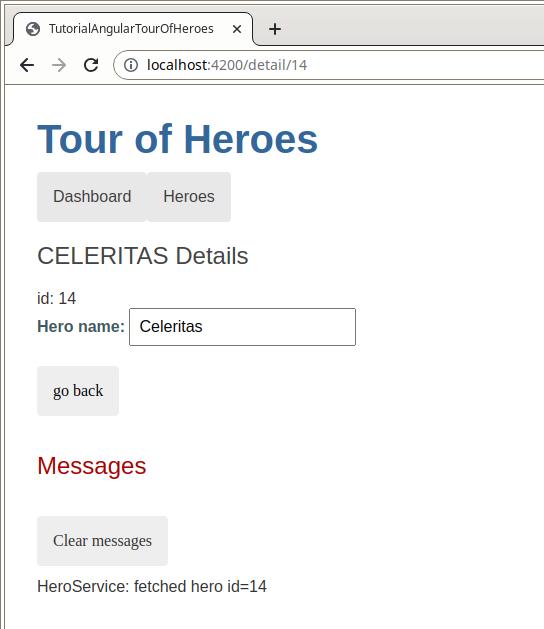Angular Tutorial - Tour of Heroes - Part 6 (Add navigation with routing)
- Introduction
- Add the AppRoutingModule
- Add RouterOutlet
- Try it
- Add a navigation link using routerLink
- Add a dashboard view
- Navigating to hero details
- Routable HeroDetailComponent
- Find the way back
Introduction
This tutorial recaps the official documentation at https://angular.io/tutorial/tour-of-heroes/toh-pt5.
The Tour of Heroes application has new requirements:
- Add a Dashboard view
- Add the ability to navigate between the Heroes and Dashboard views
- When users click a hero name in either view, navigate to a detail view of the selected hero
- When users click a deep link in an email, open the detail view for a particular hero
When you’re done, users can navigate the application like this:
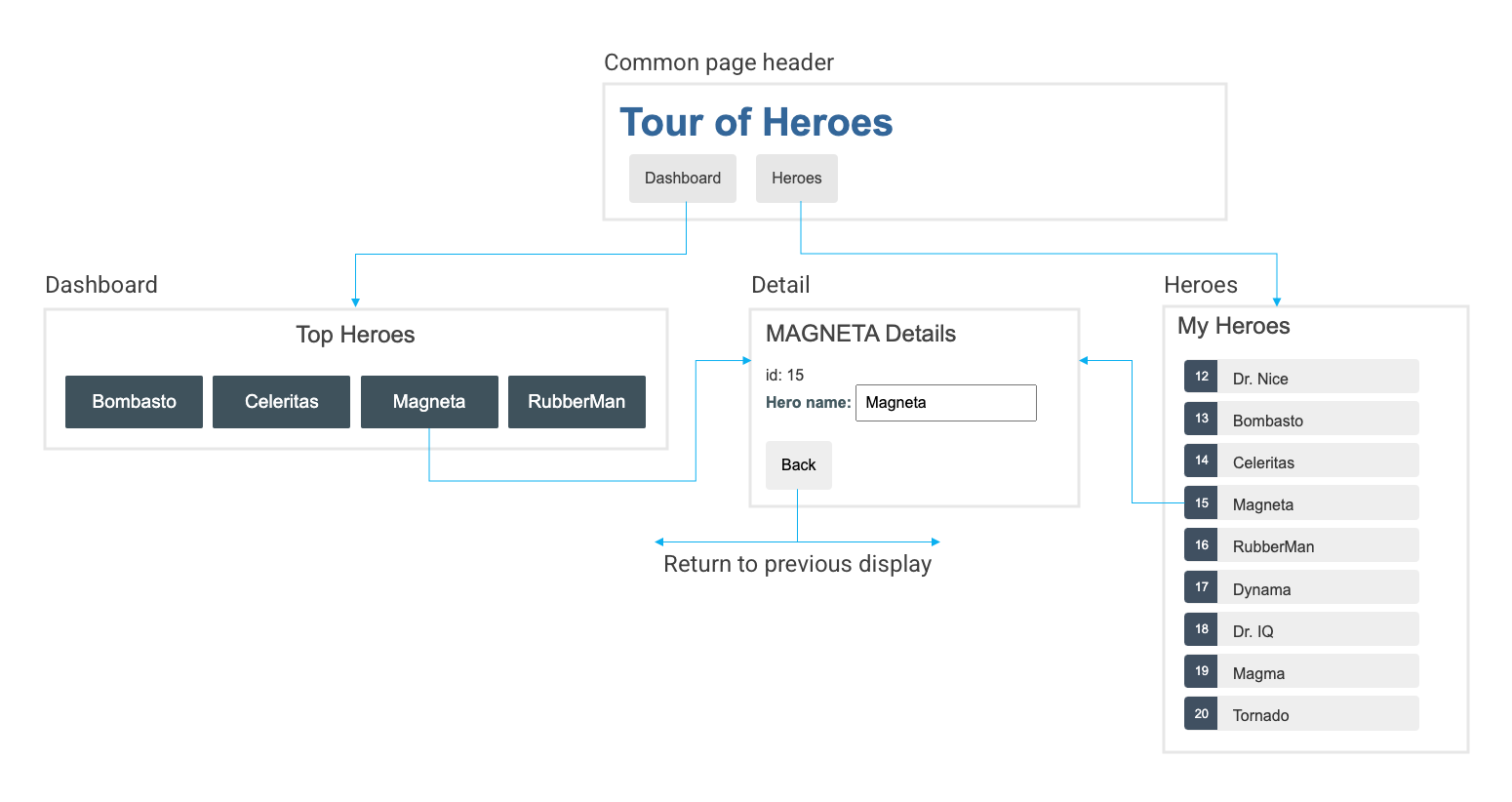
(original image from https://angular.io/generated/images/guide/toh/nav-diagram.png)
Add the AppRoutingModule
In Angular, the best practice is to load and configure the router in a separate, top-level module. The router is dedicated to routing (URLs to target views) and imported by the root AppModule.
By convention, the module class name is AppRoutingModule and it belongs in the app-routing.module.ts in the src/app directory.
Run ng generate to create the application routing module.
$ ng generate module app-routing --flat --module=app
CREATE src/app/app-routing.module.ts (196 bytes)
UPDATE src/app/app.module.ts (754 bytes)
Parameter:
--flat: Puts the file insrc/appinstead of its own directory.--module=app: Tellsng generateto register it in the imports array of theAppModule.
File src/app/app.module.ts:
import { NgModule } from '@angular/core';
import { BrowserModule } from '@angular/platform-browser';
import { FormsModule } from '@angular/forms'; // <-- NgModel lives here
import { AppComponent } from './app.component';
import { HeroesComponent } from './heroes/heroes.component';
import { HeroDetailComponent } from './hero-detail/hero-detail.component';
import { MessagesComponent } from './messages/messages.component';
import { AppRoutingModule } from './app-routing.module';
@NgModule({
declarations: [
AppComponent,
HeroesComponent,
HeroDetailComponent,
MessagesComponent
],
imports: [
BrowserModule,
FormsModule,
AppRoutingModule
],
providers: [],
bootstrap: [AppComponent]
})
export class AppModule { }
The file src/app/app-routing.module.ts that ng generate created looks like this:
import { NgModule } from '@angular/core';
import { CommonModule } from '@angular/common';
@NgModule({
declarations: [],
imports: [
CommonModule
]
})
export class AppRoutingModule { }
Replace it with the following:
import { NgModule } from '@angular/core';
import { RouterModule, Routes } from '@angular/router';
import { HeroesComponent } from './heroes/heroes.component';
const routes: Routes = [
{ path: 'heroes', component: HeroesComponent }
];
@NgModule({
imports: [RouterModule.forRoot(routes)],
exports: [RouterModule]
})
export class AppRoutingModule { }
First, the app-routing.module.ts file imports RouterModule and Routes so the application can have routing capability. The next import, HeroesComponent, gives the Router somewhere to go once you configure the routes.
Notice that the CommonModule references and declarations array are unnecessary, so are no longer part of AppRoutingModule. The following sections explain the rest of the AppRoutingModule in more detail.
Routes
The next part of the file is where you configure your routes. Routes tell the Router which view to display when a user clicks a link or pastes a URL into the browser address bar.
Since app-routing.module.ts already imports HeroesComponent, you can use it in the routes array:
File src/app/app-routing.module.ts:
const routes: Routes = [
{ path: 'heroes', component: HeroesComponent }
];
A typical Angular Route (see https://angular.io/api/router/Route) has two properties:
path: A string that matches the URL in the browser address bar.component: The component that the router should create when navigating to this route.
This tells the router to match that URL to path: 'heroes' and display the HeroesComponent when the URL is something like http://localhost:4200/heroes.
RouterModule.forRoot()
The @NgModule metadata initializes the router and starts it listening for browser location changes.
The following line adds the RouterModule to the AppRoutingModule imports array and configures it with the routes in one step by calling RouterModule.forRoot().
File src/app/app-routing.module.ts:
imports: [ RouterModule.forRoot(routes)],
Note: The method is called forRoot() because you configure the router at the application’s root level. The forRoot() method supplies the service providers and directives needed for routing, and performs the initial navigation based on the current browser URL.
Next, AppRoutingModule exports RouterModule to be available throughout the application.
File src/app/app-routing.module.ts:
exports: [ RouterModule ]
Add RouterOutlet
Open the AppComponent template and replace the <app-heroes> element with a <router-outlet> element.
File src/app/app.component.html:
<h1>{{title}}</h1>
<router-outlet></router-outlet>
<app-messages></app-messages>
The AppComponent template no longer needs <app-heroes> because the application only displays the HeroesComponent when the user navigates to it.
The <router-outlet> tells the router where to display (“embed”) routed views.
The RouterOutlet is one of the router directives that became available to the AppComponent because AppModule imports AppRoutingModule which exported RouterModule. The ng generate command you ran at the start of this tutorial added this import because of the --module=app flag. If you didn’t use the ng generate command to create app-routing.module.ts, import AppRoutingModule into app.module.ts and add it to the imports array of the NgModule.
Try it
If you’re not still serving your application, run ng serve to see your application in the browser under http://localhost:4200/.
The browser should refresh and display the application title but not the list of heroes.
Look at the browser’s address bar. The URL ends in /. The route path to HeroesComponent is /heroes.
Append /heroes to the URL in the browser address bar: http://localhost:4200/heroes.
You should see the familiar heroes overview/detail view.
Remove /heroes from the URL in the browser address bar. The browser should refresh and display the application title but not the list of heroes.
Add a navigation link using routerLink
Ideally, users should be able to click a link to navigate rather than pasting a route URL into the address bar.
Add a <nav> element and, within that, an anchor element that, when clicked, triggers navigation to the HeroesComponent. The revised AppComponent template looks like this:
File src/app/app.component.html:
<h1>{{title}}</h1>
<nav>
<a routerLink="/heroes">Heroes</a>
</nav>
<router-outlet></router-outlet>
<app-messages></app-messages>
A routerLink attribute is set to “/heroes”, the string that the router matches to the route to HeroesComponent. The routerLink is the selector for the RouterLink directive that turns user clicks into router navigations. It’s another of the public directives in the RouterModule.
The browser refreshes and displays the application title and heroes link, but not the heroes list.
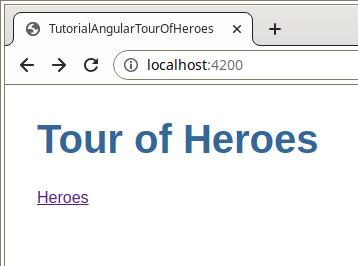
Click the link. The address bar updates to /heroes and the list of heroes appears.
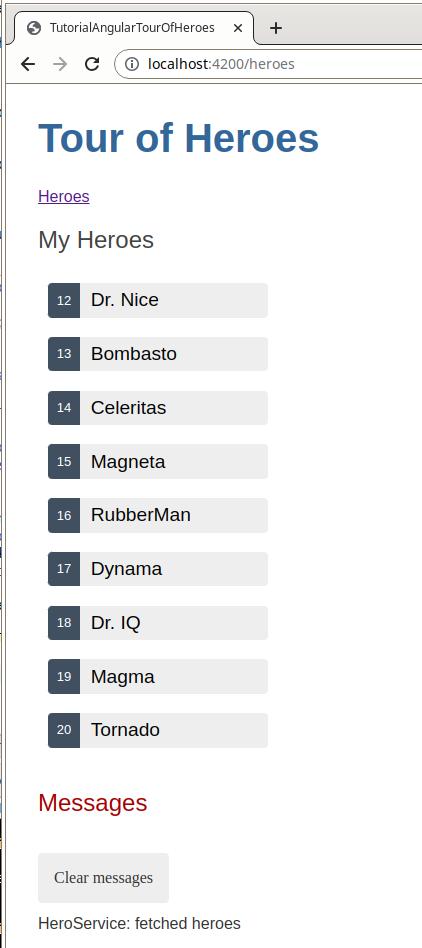
Make this and future navigation links look better by adding private CSS styles to src/app/app.component.css:
/* AppComponent's private CSS styles */
h1 {
margin-bottom: 0;
}
nav a {
padding: 1rem;
text-decoration: none;
margin-top: 10px;
display: inline-block;
background-color: #e8e8e8;
color: #3d3d3d;
border-radius: 4px;
}
nav a:hover {
color: white;
background-color: #42545C;
}
nav a:active {
background-color: black;
}
Add a dashboard view
Routing makes more sense when your application has more than one view, yet the Tour of Heroes application has only the heroes view.
To add a DashboardComponent, run ng generate as shown here:
$ ng generate component dashboard
CREATE src/app/dashboard/dashboard.component.css (0 bytes)
CREATE src/app/dashboard/dashboard.component.html (24 bytes)
CREATE src/app/dashboard/dashboard.component.spec.ts (580 bytes)
CREATE src/app/dashboard/dashboard.component.ts (214 bytes)
UPDATE src/app/app.module.ts (848 bytes)
ng generate creates the files for the DashboardComponent and declares it in AppModule.
Replace the default content in these files as shown here:
File src/app/dashboard/dashboard.component.html:
<h2>Top Heroes</h2>
<div class="heroes-menu">
<a *ngFor="let hero of heroes">
</a>
</div>
The template presents a grid of hero name links.
- The
*ngForrepeater creates as many links as are in the component’sheroesarray. - The links are styled as colored blocks by the
dashboard.component.css. - The links don’t go anywhere yet.
File src/app/dashboard/dashboard.component.ts:
import { Component, OnInit } from '@angular/core';
import { Hero } from '../hero';
import { HeroService } from '../hero.service';
@Component({
selector: 'app-dashboard',
templateUrl: './dashboard.component.html',
styleUrls: [ './dashboard.component.css' ]
})
export class DashboardComponent implements OnInit {
heroes: Hero[] = [];
constructor(private heroService: HeroService) { }
ngOnInit(): void {
this.getHeroes();
}
getHeroes(): void {
this.heroService.getHeroes()
.subscribe(heroes => this.heroes = heroes.slice(1, 5));
}
}
The class is like the HeroesComponent class.
- It defines a
heroesarray property - The constructor expects Angular to inject the
HeroServiceinto a privateheroServiceproperty - The
ngOnInit()lifecycle hook callsgetHeroes() - This
getHeroes()returns the sliced list ofheroesat positions 1 and 5, returning only Heroes two, three, four, and five.
File src/app/dashboard/dashboard.component.css:
/* DashboardComponent's private CSS styles */
h2 {
text-align: center;
}
.heroes-menu {
padding: 0;
margin: auto;
max-width: 1000px;
/* flexbox */
display: flex;
flex-direction: row;
flex-wrap: wrap;
justify-content: space-around;
align-content: flex-start;
align-items: flex-start;
}
a {
background-color: #3f525c;
border-radius: 2px;
padding: 1rem;
font-size: 1.2rem;
text-decoration: none;
display: inline-block;
color: #fff;
text-align: center;
width: 100%;
min-width: 70px;
margin: .5rem auto;
box-sizing: border-box;
/* flexbox */
order: 0;
flex: 0 1 auto;
align-self: auto;
}
@media (min-width: 600px) {
a {
width: 18%;
box-sizing: content-box;
}
}
a:hover {
background-color: #000;
}
Add the dashboard route
To navigate to the dashboard, the router needs an appropriate route.
Import the DashboardComponent in the app-routing.module.ts file
and add a route to the routes array that matches the path dashboard to the DashboardComponent.
File src/app/app-routing.module.ts:
import { NgModule } from '@angular/core';
import { RouterModule, Routes } from '@angular/router';
import { HeroesComponent } from './heroes/heroes.component';
import { DashboardComponent } from './dashboard/dashboard.component';
const routes: Routes = [
{ path: 'heroes', component: HeroesComponent },
{ path: 'dashboard', component: DashboardComponent }
];
Add a default route
When the application starts, the browser’s address bar points to the web site’s root ('' or /). That doesn’t match any existing route so the router doesn’t navigate anywhere. The space below the <router-outlet> is blank.
To make the application navigate to the dashboard automatically, add the following route to the routes array.
File src/app/app-routing.module.ts:
{ path: '', redirectTo: '/dashboard', pathMatch: 'full' },
This route redirects a URL that fully matches the empty path to the route whose path is ‘/dashboard’.
After the browser refreshes, the router loads the DashboardComponent and the browser address bar shows the /dashboard URL.
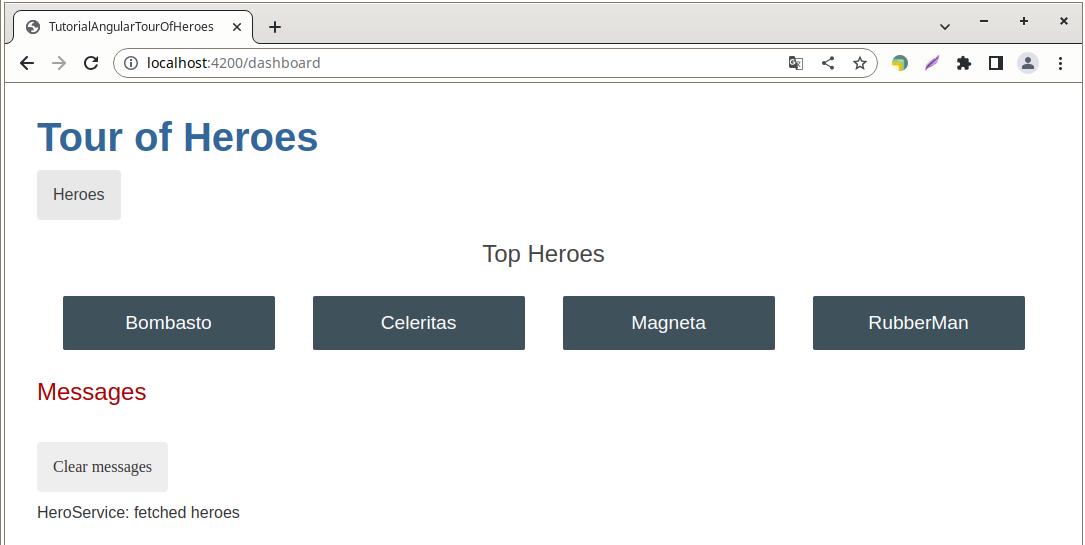
Add dashboard link to the shell
The user should be able to navigate between the DashboardComponent and the HeroesComponent by clicking links in the navigation area near the top of the page.
Add a dashboard navigation link to the AppComponent shell template, just above the Heroes link.
File src/app/app.component.html:
<h1>{{title}}</h1>
<nav>
<a routerLink="/dashboard">Dashboard</a>
<a routerLink="/heroes">Heroes</a>
</nav>
<router-outlet></router-outlet>
<app-messages></app-messages>
After the browser refreshes you can navigate freely between the two views by clicking the links.
Navigating to hero details
The HeroDetailComponent displays details of a selected hero. At the moment the HeroDetailComponent is only visible at the bottom of the HeroesComponent.
The user should be able to get to these details in three ways.
- By clicking a hero in the dashboard.
- By clicking a hero in the heroes list.
- By pasting a “deep link” URL into the browser address bar that identifies the hero to display.
This section enables navigation to the HeroDetailComponent and liberates it from the HeroesComponent.
Delete hero details from HeroesComponent
When the user clicks a hero in HeroesComponent, the application should navigate to the HeroDetailComponent, replacing the heroes list view with the hero detail view. The heroes list view should no longer show hero details as it does now.
Open the src/app/heroes/heroes.component.html and delete the <app-hero-detail> element from the bottom.
Clicking a hero item now does nothing. You can fix that after you enable routing to the HeroDetailComponent.
Add a hero detail route
An URL like ~/detail/11 would be a good URL for navigating to the Hero Detail view of the hero whose id is 11.
Open file src/app/app-routing.module.ts and
- import
HeroDetailComponent - add a
parameterizedroute to theroutesarray (and we sorted it alphabetically for better overview) that matches the path pattern to thehero detail view
import { NgModule } from '@angular/core';
import { RouterModule, Routes } from '@angular/router';
import { HeroesComponent } from './heroes/heroes.component';
import { DashboardComponent } from './dashboard/dashboard.component';
import { HeroDetailComponent } from './hero-detail/hero-detail.component';
const routes: Routes = [
{ path: '', redirectTo: '/dashboard', pathMatch: 'full' },
{ path: 'dashboard', component: DashboardComponent },
{ path: 'detail/:id', component: HeroDetailComponent },
{ path: 'heroes', component: HeroesComponent },
];
@NgModule({
imports: [RouterModule.forRoot(routes)],
exports: [RouterModule]
})
export class AppRoutingModule { }
The colon : character in the path indicates that :id is a placeholder for a specific hero id.
At this point, all application routes are in place.
DashboardComponent hero links
The DashboardComponent hero links do nothing at the moment.
Now that the router has a route to HeroDetailComponent, fix the dashboard hero links to navigate using the parameterized dashboard route.
File src/app/dashboard/dashboard.component.html:
<h2>Top Heroes</h2>
<div class="heroes-menu">
<a *ngFor="let hero of heroes" routerLink="/detail/{{hero.id}}">
</a>
</div>
You’re using Angular interpolation binding (see https://angular.io/guide/interpolation) within the *ngFor repeater (see https://angular.io/api/common/NgFor) to insert the current iteration’s hero.id into each routerLink.
HeroesComponent hero links
The hero items in the HeroesComponent are <li> elements whose click events are bound to the component’s onSelect() method.
Actual File src/app/heroes/heroes.component.html:
<ul class="heroes">
<li *ngFor="let hero of heroes">
<button type="button" (click)="onSelect(hero)" [class.selected]="hero === selectedHero">
<span class="badge">{{hero.id}}</span>
<span class="name">{{hero.name}}</span>
</button>
</li>
</ul>
Remove the inner HTML of <li>. Wrap the badge and name in an anchor <a> element. Add a routerLink attribute to the anchor that’s the same as in the dashboard template.
New File src/app/heroes/heroes.component.html:
<ul class="heroes">
<li *ngFor="let hero of heroes">
<a routerLink="/detail/{{hero.id}}">
<span class="badge">{{hero.id}}</span> {{hero.name}}
</a>
</li>
</ul>
Be sure to fix the private style sheet in src/app/heroes/heroes.component.css to make the list look as it did before:
/* HeroesComponent's private CSS styles */
.heroes {
margin: 0 0 2em 0;
list-style-type: none;
padding: 0;
width: 15em;
}
.heroes li {
position: relative;
cursor: pointer;
}
.heroes li:hover {
left: .1em;
}
.heroes a {
color: #333;
text-decoration: none;
background-color: #EEE;
margin: .5em;
padding: .3em 0;
height: 1.6em;
border-radius: 4px;
display: block;
width: 100%;
}
.heroes a:hover {
color: #2c3a41;
background-color: #e6e6e6;
}
.heroes a:active {
background-color: #525252;
color: #fafafa;
}
.heroes .badge {
display: inline-block;
font-size: small;
color: white;
padding: 0.8em 0.7em 0 0.7em;
background-color: #405061;
line-height: 1em;
position: relative;
left: -1px;
top: -4px;
height: 1.8em;
min-width: 16px;
text-align: right;
margin-right: .8em;
border-radius: 4px 0 0 4px;
}
Remove dead code - optional
While the HeroesComponent class still works, the onSelect() method and selectedHero property are no longer used.
It’s nice to tidy things up for your future self. Here’s the class after pruning away the dead code.
File src/app/heroes/heroes.component.ts:
import { Component, OnInit } from '@angular/core';
import { Hero } from '../hero';
import { HeroService } from '../hero.service';
@Component({
selector: 'app-heroes',
templateUrl: './heroes.component.html',
styleUrls: ['./heroes.component.css']
})
export class HeroesComponent implements OnInit {
heroes: Hero[] = [];
constructor(private heroService: HeroService) { }
ngOnInit(): void {
this.getHeroes();
}
getHeroes(): void {
this.heroService.getHeroes()
.subscribe(heroes => this.heroes = heroes);
}
}
Routable HeroDetailComponent
The parent HeroesComponent used to set the HeroDetailComponent.hero property and the HeroDetailComponent displayed the hero.
HeroesComponent doesn’t do that anymore. Now the router creates the HeroDetailComponent in response to a URL such as ~/detail/12.
The HeroDetailComponent needs a new way to get the hero to display. This section explains the following:
- Get the route that created it
- Extract the
idfrom the route - Get the hero with that
idfrom the server using theHeroService
Steps:
- Add the imports for
ActivatedRoute(see https://angular.io/api/router/ActivatedRoute),Location(see https://angular.io/api/common/Location) andHeroService - Inject the
ActivatedRoute,HeroService, andLocationservices into the constructor, saving their values in private fields
File src/app/hero-detail/hero-detail.component.ts:
import { Component, Input } from '@angular/core';
import { ActivatedRoute } from '@angular/router';
import { Location } from '@angular/common';
import { Hero } from '../hero';
import { HeroService } from '../hero.service';
@Component({
selector: 'app-hero-detail',
templateUrl: './hero-detail.component.html',
styleUrls: ['./hero-detail.component.css']
})
export class HeroDetailComponent {
@Input() hero?: Hero;
constructor(
private route: ActivatedRoute,
private heroService: HeroService,
private location: Location
) {}
}
The ActivatedRoute holds information about the route to this instance of the HeroDetailComponent. This component is interested in the route’s parameters extracted from the URL. The “id” parameter is the id of the hero to display.
The HeroService gets hero data from the remote server and this component uses it to get the hero-to-display.
The Location is an Angular service for interacting with the browser. This service lets you navigate back to the previous view.
Extract the id route parameter
- Add implements
OnInitand add import forOnInit. - Change hero
property: remove@Input()and change line tohero: Hero | undefined;, removeInputimport - In the
ngOnInit()lifecycle hook callgetHero()and define it as follows.
File src/app/hero-detail/hero-detail.component.ts
import { Component, OnInit } from '@angular/core';
import { ActivatedRoute } from '@angular/router';
import { Location } from '@angular/common';
import { Hero } from '../hero';
import { HeroService } from '../hero.service';
@Component({
selector: 'app-hero-detail',
templateUrl: './hero-detail.component.html',
styleUrls: ['./hero-detail.component.css']
})
export class HeroDetailComponent implements OnInit {
hero: Hero | undefined;
constructor(
private route: ActivatedRoute,
private heroService: HeroService,
private location: Location
) {}
ngOnInit(): void {
this.getHero();
}
getHero(): void {
const id = Number(this.route.snapshot.paramMap.get('id'));
this.heroService.getHero(id).subscribe(hero => this.hero = hero);
}
}
The route.snapshot is a static image of the route information shortly after the component was created.
The paramMap is a dictionary of route parameter values extracted from the URL. The “id” key returns the id of the hero to fetch.
Route parameters are always strings. The JavaScript Number function converts the string to a number, which is what a hero id should be.
The browser refreshes and the application crashes with a compiler error. HeroService doesn’t have a getHero() method. Add it now.
Add HeroService.getHero()
Open HeroService and add the following getHero() method with the id after the getHeroes() method:
File src/app/hero.service.ts:
getHero(id: number): Observable<Hero> {
// For now, assume that a hero with the specified `id` always exists.
// Error handling will be added in the next step of the tutorial.
const hero = HEROES.find(h => h.id === id)!;
this.messageService.add(`HeroService: fetched hero id=${id}`);
return of(hero);
}
IMPORTANT: The backtick (`) characters define a JavaScript template literal (see https://developer.mozilla.org/en-US/docs/Web/JavaScript/Reference/Template_literals) for embedding the id.
Like getHeroes(), getHero() has an asynchronous signature. It returns a mock hero as an Observable, using the RxJS of() function.
You can rewrite getHero() as a real Http request without having to change the HeroDetailComponent that calls it (see next tutorial part).
Try it
The browser refreshes and the application is working again. You can click a hero in the dashboard or in the heroes list and navigate to that hero’s detail view.
If you paste http://localhost:4200/detail/12 in the browser address bar, the router navigates to the detail view for the hero with id: 12, “Dr Nice”.
Find the way back
By clicking the browser’s back button, you can go back to the previous page. This could be the hero list or dashboard view, depending upon which sent you to the detail view.
It would be nice to have a button on the HeroDetail view that can do that.
Add a go back button to the bottom of the component template and bind it to the component’s goBack() method.
File src/app/hero-detail/hero-detail.component.html:
<div *ngIf="hero">
<h2> Details</h2>
<div><span>id: </span></div>
<div>
<label for="hero-name">Hero name: </label>
<input id="hero-name" [(ngModel)]="hero.name" placeholder="name">
</div>
<button type="button" (click)="goBack()">go back</button>
</div>
Add a goBack() method to the component class that navigates backward one step in the browser’s history stack using the Location service that you used to inject.
File src/app/hero-detail/hero-detail.component.ts:
goBack(): void {
this.location.back();
}
Refresh the browser and start clicking. Users can now navigate around the application using the new buttons.
The details look better when you add the private CSS styles to src/app/hero-detail/hero-detail.component.css:
/* HeroDetailComponent's private CSS styles */
label {
color: #435960;
font-weight: bold;
}
input {
font-size: 1em;
padding: .5rem;
}
button {
margin-top: 20px;
background-color: #eee;
padding: 1rem;
border-radius: 4px;
font-size: 1rem;
}
button:hover {
background-color: #cfd8dc;
}
button:disabled {
background-color: #eee;
color: #ccc;
cursor: auto;
}
